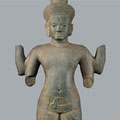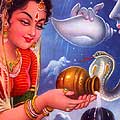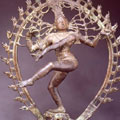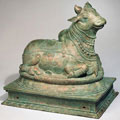|
|
 |
 |
| Shiva |
|
|
The cult of Shiva is one of complex contradictions (Figure 1). Shiva is the ultimate ascetic: his hair is matted and unkempt, and his body is white from being smeared with the ashes of the cremation ground, an unclean place that reminds us of the ultimately temporary nature of existence. He is known to possess sometimes frightening and dangerous yogic powers. He is also married to the Goddess Parvati, and is intimately tied to the Goddess in her many other forms as well.
Like Vishnu, Shiva is known by a number of names, such as Nataraja ("King of Dance") and Mahadeva ("Great Lord"). Shiva's physical manifestation as an image also takes a variety of forms. The most common is the shiva linga (Figure 2). Although the origin of this form may have been the phallus representing the potential and controlled power of the God, this association has largely been lost, and the shiva linga is now considered non-anthropomorphic (aniconic). One of the most famous images of Shiva is that of Nataraja, in which Shiva is portrayed performing his dance of destruction (Figure 3). Shiva is regarded in some formulations as the lord of destruction, in a triad alongside Brahma, the creator, and Vishnu, the preserver. Those devoted to Shiva, however, portray him as all-powerful and attribute to him all of these roles.
Nandi, the bull, is the vehicle (vahana) or animal mount associated with Shiva (Figure 4). Most Gods and Goddesses are associated with animal mounts: Ganesha's is the rat, Durga's is the lion, and Vishnu's is the bird Garuda. Nandi is a particularly prominent vehicle. In many Shiva temples, a sculpture of Nandi is placed directly opposite the entrance to the central shrine containing the central image of Shiva, the shiva linga. This configuration, in which Nandi sits facing a shiva linga, can also be seen in smaller shrines. In this position, Nandi is acting not only as Shiva's guardian, but also as a constant devotee. Thus Nandi himself, who mimics the position of every devotee who comes to stand before the central shrine and interact with the divine image, is often revered as a model devotee.
< previous next >
Top |
|
 |
 |
| Click for details |
 |
 |
 |
Fig. 1
|
 |
 |
 |
Fig. 2
|
 |
 |
 |
Fig. 3
|
 |
 |
 |
Fig. 4
|
 |
|
 |


